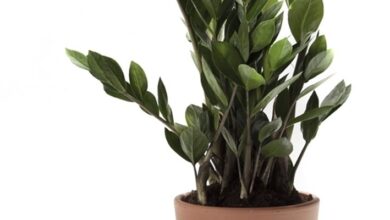How to cure fungi on plant leaves

Plants can be affected by various types of fungi. Some will weaken the roots first, others the trunk or stem, and others the leaves, which is what usually worries us the most since it is the most visible. What do we have to do in these cases?
To do this, I am going to explain to you how to cure fungi on plant leaves and, also, what you can do to prevent them from reappearing.
How to remove fungi from leaves?
Fungi are microorganisms that love to take advantage of the slightest sign of plant weakness to invade them and harm them even more. Above all, they will feel very comfortable if they are in corners protected from direct sun and in a humid environment, so it would not be strange if a plant that is suffering from excessive watering was affected, sooner or later, by these fungi. tenants.
What to do to eliminate them? There are three different treatments that we can follow either first thing in the morning or late in the afternoon:
Home remedies
Copper or sulfur

We put two tablespoons of copper or sulfur in a watering can with 1 liter of water (do not use a spray as it would get stuck right away) and water the affected plant from above.
Sodium bicarbonate
We mix the following in a sprayer:
- 1 tablespoon of baking soda
- 1 teaspoon of liquid soap
- 4 cups of water
Chemical remedy
When the plant is really very weakened, it is best to treat it with spray systemic fungicides. We spray all its parts well, every time the product packaging tells us to.
How to prevent fungus on plants?
The best way to prevent them is by controlling the risks. You have to water only when necessary, no more and no less. We have to think that an excess of water can kill the plants, not only because of the water itself but also because of what it causes (root suffocation + general weakening = fungi).
Whenever we have doubts, we have to check the humidity of the soil, either by digging a little with our fingers, inserting a thin wooden stick, or weighing the pot once it has been watered and again after a few days. Likewise, we must avoid putting a plate under them, unless we are in the middle of summer and we have plants that want a lot of water (rose bushes, palm trees, flowers) in full sun.
What are the fungi that most affect crops?
Plants can become ill with fungi at any time, especially during the summer since this is when we water the most, coinciding with the increase in temperatures, and in many points, also with drought. But without realizing it, we can create the perfect environment for fungi; hence it is so important to control risks.
Furthermore, if we live in an area where the humidity is high, we will also have to make sure that the substrate or soil is porous, light, and therefore allows the roots to be well aerated. In this way, we can reduce the risk of rot, perhaps not completely, but enough to save many crops.
But, did you know that there are several types of mushrooms? The diseases that they cause to plants are:
Browning of conifers
The browning of conifers is a disease caused by the fungus Phytophthora infestans (Phytophthora). It first affects the roots, which will no longer be able to absorb water, and from there it goes to the branches and then to the leaves. The plant will look sad, with the foliage turning from yellow to brown in a matter of days to a few weeks (depending on weather and soil conditions).
Unfortunately there is no treatment, but there is prevention. In fact, you can prevent your plants from having it by:
- When making a hedge, you put them apart, at least about 50 centimeters. It is of vital importance for them that the air can circulate on their sides, since this way the fungi will not be able to do anything.
- You make sure that the soil drains the water quickly. If it tends to puddle, it is better to install a drainage system.
- You carry out preventive treatments with a specific fungicide for conifers, during the spring and summer.
- You don’t buy diseased plants. If they have yellowish or dry leaves, the ideal is to leave them in the nursery so that they do not infect others.
Botrytis

The botrytis cause Botryotinia fungus (Botrytis or) that rots irremediably damaged fruit and leaves. It also affects the bulbs, which end up dying as the disease progresses.
The most visible symptom is the appearance of a grayish powder or mold on the affected parts, in addition to a progressive decay of the plant. Fortunately, if it is detected in time, the diseased part can be cut (if it is from the aerial part of the plant) with disinfected scissors, and treated with fungicide.
If the bulb has been damaged, the ideal is to throw everything (bulb and soil), since if it is thrown into the garden for example, it could infect other plants.
Damping-off or death of seedlings

Image – Flickr/ Scot Nelson
The damping-off is a common fungal disease in seedbeds, especially trees but can affect any type of plant. The symptoms appear either in the seeds, which rot, or when the seedling is growing, affecting the roots, rendering them useless. It also shows a brown spot at the base of the stem, which increases in size as the infection progresses.
It is caused by different fungi, including Rhizoctonia solani or Thielaviopsis basicola. And despite what it may seem, it is quite easily prevented if copper or sulfur is added every so often (10-15 days) in the seedbed, during spring and fall. In summer, spray fungicides.
Sooty mold or bold

Image – Wikimedia/ Bidgee
The fumagina or bold is a disease that occurs when there is uncontrolled cochineal, aphid or whitefly pest. These parasites excrete a honeydew that is very attractive to the fungus, so it takes advantage of the situation.
It is common in rose bushes and in citrus (orange, lemon, etc.). It is not serious, but it does make the plants quite ugly, since they end up having the leaves with ‘dirt’, which is nothing more than a kind of black scab.
To control it, pests must first be eliminated, for example with diatomaceous earth, neem oil or potassium soap. Once they are eradicated, you can treat with fungicide, or clean them conscientiously (if the plant is not very large, it is interesting to clean the leaves with soap and water).
Pink palm mushroom

Image -Insectimages.org
The pink fungus of palm trees, whose scientific name is Gliocadium vermoesenii, is a fungal species that affects, as its name suggests, especially palm trees. A warm and humid environment is a breeding ground for this species, which will infect the plant at the slightest sign of weakness.
The symptoms are:
- necrotic spots in the entrance or wound area
- appearance of pink powder in the affected area
- premature leaf death
Can it be treated? Not from experience. Palm trees only have one growth guide, and when the central leaf becomes infected, it is because the guide is badly damaged. Therefore, the ideal is to prevent, with preventive treatments with copper or sulfur, and keeping the plants well watered and aerated.
Mildew

Image – Wikimedia/ Rob Hille
The downy is the name of a disease caused by fungi of the Peronosporaceae family. They affect the leaves, which will have light greenish spots at first, and then brown on the upper side; on the underside they may have grayish powder. It also affects the stems and fruits.
It is favored by warm environments, with temperatures above 25ºC, so during this time it will be very necessary to avoid waterlogging. And if symptoms occur, you have to treat with fungicide.
Powdery mildew

The powdery mildew is a disease known as powdery mildew or fungal blanquilla the Erisifaceae family. A kind of white or grayish powder will appear on the leaves of the affected plants, with a mealy appearance, which will prevent them from photosynthesis. Consequently, these leaves turn yellow and fall.
If we use a lot of nitrogen-rich fertilizers and/ or grow plants in areas with little light and poor ventilation, we promote infection. For this reason, it is important that they are properly aired, and that they receive the amount of light they need. Also, if symptoms appear, they must be treated with copper.
Rust

The rust is very frequent in ornamental plants. It is transmitted by a series of fungi of the class Pucciniomycetes. Once infection has occurred, red bumps or bumps will appear on the underside of the leaves, and yellow spots on the upper side.
What to do? A good natural remedy against this disease is to apply Bordeaux mixture in spring, or spray fungicides the rest of the year.
We hope that now you can identify and treat your plants when they have fungus.


